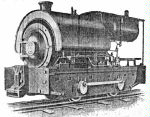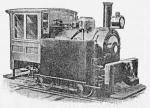"This type is being used extensively for contracting, plantation and on light passenger and freight railway service. Such firms as New Jersey Zinc Co., W. R. Grace & Co., Central Santa Dominican Railway and many others use this type. It may be had in sizes from 4 to 20 tons for any gauge 18 inches or over. With open or closed cab."
"The Bell Side Tank Locomotive is used where an extra large water capacity is required. It also has a low center of gravity and may be used over rough uneven track and roadbed. .... The West Virginia Pulp and Paper Co. operate this side tank type of Locomotive in their lumber camps."
"Bell Side Tank, Oil Burning Steam Geared Locomotive. Sizes 4 to 20 tons. For any gauge."

"This type of Bell Locomotive is very popular with the general contractor and is used extensively on road construction, subway and tunnel work, bridge building, aqueduct work. Also has bet with success in brick yards, clay pits, quarries, etc. Because of the elimination of the fire risk many sugar, fruit and hemp plantations have adopted them as standard.
This Bell Oil Burning Steam Locomotive is easily operated; has one valve fire control; flexible spring construction; lowest possible center of gravity; rugged construction and uses the cheapest fuel.
This open cab, canopy top locomotive is supplied with side curtains to protect driver.
Bell Standard Open Cab Type Locomotive. Sizes 3, 4, 5, 6, 7, 8, 9, 10, 12 tons. For any gauge desired. No sparks, hot ashes, smoke nor obnoxious fumes"

"Bell Open Cab Saddle Tank Locomotives ar also extensively used for general contracting and industrial work. Any size, 3 to 20 tons, as desired and for any gauge will be supplied".
"For long hauls with speeds up to 30 miles per hour the Bell Locomotive Tender Type affects savings in fuel and upkeep cost. The geared engine permits operation on long heavy grades with maximum train load. The Standard Oil Co. use this type locomotive on their South American properties. A large supply of water and fuel may be carried."

"Bell Oil-Burning Locomotive as illustrated may be had in 14, 15, 16, 17, 18 and 20 tons. Rear wheel articulated where curves are too severe for six-wheel connected locomotive"
The company also offered a smaller version (12 tons and less) of this type "designed for use on light rails with extremely sharp curves."

"This locomotive used extensively by Road Contractors, Industrial Plants, Logging Camps, For Switching Purposes, General Contracting Etc."

"The Bell Condensing Type Locomotive finds its field in mines, tunnel and subway work. The locomotive illustrated on this page weighs six tons, is 43 1/2" high and 11' 3" long. The width depends on the gauge. Overall dimensions can be still further reduced for restricted clearances. This locomotive is recommended for use where ventilation is fairly good with kerosene as fuel."
"Practically all steam is condensed which prevents the rotting or loosening of timbers and earth overhead. The exhaust is underneath the locomotive."

"The Bell Self-Propelled Passenger and Baggage Cars fill many requirements. Excellent for service on short branch lines both in the United States and in foreign countries. Many plantations use this type as a workman's car.
Narrow-gauge railways in Central and South America and the West Indies find these cars cheap to operate and maintain.
Modified type of this car has many advantages for "hump" freight yard service."
"This car may be had with open canopy top as illustrated or with completely enclosed body as specified."


